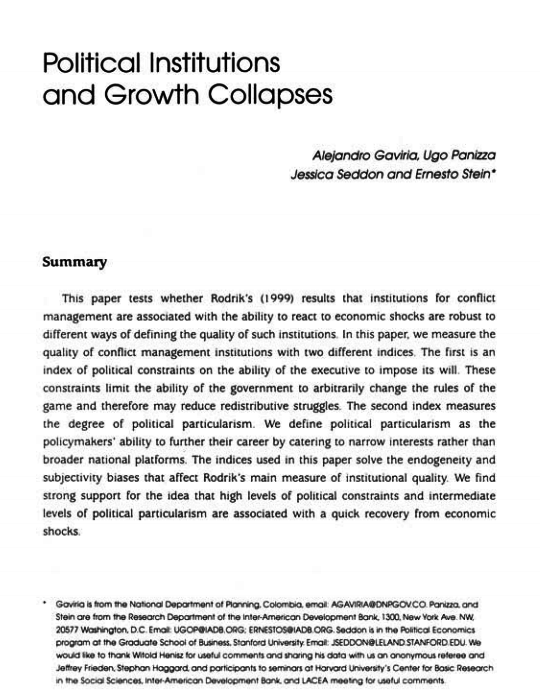Political Institutions and Growth Collapses
DOI:
https://doi.org/10.35319/lajed.20042318Keywords:
Confict management, Economic Shocks, RecoveryAbstract
This paper tests whether Rodrik's (1999) results that institutions for conflict management are associated with the ability to react to economic shocks are robust to different ways of defining the quality of such institutions. In this paper, we measure the quality of conflict management institutions with two different indices. The first is an index of political constraints on the ability of the executive to impose its will. These constraints limit the ability of the government to arbitrarily change the rules of the game and therefore may reduce redistributive struggles. The second index measures the degree of political particularism. We define political particularism as the policymakers' ability to further their career by catering to narrow interests rather than broader national platforms. The indices used in this paper solve the endogeneity and subjectivity biases that affect Rodrik's main measure of institutional quality. We find strong support for the idea that high levels of political constraints and intermediate levels of political particularism are associated with a quick recovery from economic shocks.
Downloads
References
Baqir, Reza (1999) “Districts, Spillovers, and Government Overspending.” mimeo, University of California at Berkeley.
Cain, Bruce, Ferejohn, John, and Fiorina, Morris (1987) The Personal Vote: Constituency Service and Electoral Independence. Cambridge: Harvard University Press.
Carey, John, and Shugart, Matthew (1995) “Incentives to Cultivate a Personal Vote: A Rank Ordering of Electoral Formulas.” Electoral Studies 14: 417-439.
Cox, Gary (1990) “Centripetal and Centrifugal Forces in Electoral Systems.” American Journal of Political Science 34: 903-935.
Cox, Gary (1997) Making Votes Count: Strategic Coordination in the World’s Electoral Systems. Cambridge: Cambridge University Press.
Graham, Carol, Merilee Grindle, Eduardo Lora, and Jessica Seddon (1999) Improving the Odds: Political Strategies for Institutional Reform in Latin America. Latin American Research Network, Inter-American Development Bank.
Jaggers, Keith and Ted Robert Gurr (1996) “POLITY III: Regime Change and Political Authority, 1800-1994” Ann Arbor, MI: Inter-University Consortium for Political and Social Research
Henisz, Witold (2000) “The Institutional Environment for Economic Growth.” Economics and Politics, 12: 1-31.
La Porta, Rafael, Florencio Lopez de Silanes, Andrei Shleifer, and Robert Vishny (1999), The Quality of Government. Journal of Law Economics and Organization 15, 222-279.
Mainwaring, Scott, and Timoty Scully (1995) Building Democratic Institutions: Party Systems in Latin America. Stanford: Stanford University Press.
Milesi-Ferreti, Gian-Maria, Roberto Perotti, and Massimo Rostagno. 2002. “Electoral Systems and Public Spending.” Quarterly Journal of Economics 117(2):609-657
Myerson, Roger (1999) “Theoretical Comparisons of Electoral Systems.” European Economic Review, 43: 671-697.
Panizza, Ugo (2001) “Electoral Rules, Political Systems, and Institutional Quality.” Economics and Politics 13: 311-342.
Reynolds, Andrew (1997) International IDEA Handbook of Electoral System Design. Stockholm: International IDEA.
Rodrik, Dani (1999) “Where Did All the Growth Go? External Shocks, Social Conflict and Growth Collapses.” Journal of Economic Growth, 4: 385-412.
Rodrik, Dani (2000a) “Participatory Politics, Social Cooperation, and Economic Stability.” Mimeo, Harvard University.
Rodrik, Dani (2000b) “Development Strategies for the Next Century.” Mimeo, Harvard University.
Rodrik, Dani (2000c). “Institutions for High Quality Growth: What They Are and How to Acquire Them?” NBER Working Paper N. 7540.
Sealy, Thomas (1999) International Country Risk Guide, East Syracuse, PRS Group.
Seddon, Jessica, Alejandro Gaviria, Ugo Panizza and Ernesto Stein (2003) “Particularism Around the World,” World Bank Economic Review17: 133-143.
Shugart, Matthew (2001) “Extreme Electoral Systems and the Appeal of the Mixed-Member Alternative.” In Matthew Shugart and Martin Wattenburg, eds., Mixed-Member Electoral Systems, The Best of Both Worlds? New York: Oxford University Press.
Taagepera and Shugart (1989) Seats and Votes: The Effects and Determinants of Electoral Systems. New Haven: Yale University Press.
Tornell, Aaron, Philip Lane (1998.) “The Voracity Effect.” American Economic Review, 89: 22-46.
Weingast, Barry, Shepsle, Kenneth, Johnsen, Christopher (1981) “The Political Economy of Benefits and Costs: A Neoclassical Approach to Distributive Politics.” Journal of Political Economy, 89: 642-64.






